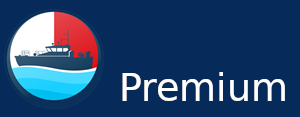1. What is the Pivot Point (PP): The pivot point is per definition the point where the ship is turning around momentarily – it is the point where the transverse speed component of a rigid body like a ship is zero; before and behind this point the transverse speed components have opposite directions. So it is real - and not “a trick of the eye” or “virtual point of rotation” etc. (The only thing what should be pointed out: Under the effect of current there will be a difference between the Pivot Point through water and PP over ground!).
2. What is the PP positon depending on? – The position of the PP is depending on the ratio of drift motion (transverse peed) and the turning motion Rate of Turn:
a. If there is pure turning then the PP is at the middle of the ship length - the transverse speed components at bow and stern are equal but with opposite directions.
b. When drift speed is added to turning motion then the turning point moves out of the centre to bow or stern – it is still on the ship lengths when the transverse speed components at bow and stern are different but with opposite directions.
c. If the drift speed is higher than the rotational speed at bow or stern then the PP moves in front of the bow or behind the stern.
d. For pure drifting motion and no turning the PP is in infinite distance.
3. Is the PP applicable as a reference Point or even fulcrum to use the distance to the PP as lever for creating a turning moment by a force? - No, not at all: Because due to the effect of the force mostly the PP will immediately move to another position! Therefore in all simulation systems normally the Centre of Gravity is being used as origin of the coordinate system where the balance of all forces and moments will be used to calculate the future motion of the ship – and there are more effects to take into account than the lateral resistance and the centre of this force…
4. So where we can finally expect the PP to be under the effect of control forces or external effects: to say the truth: simulation would help to find the answer therefore we set out to develop the Fast Time Simulation system SAMMON to support training and even more the conning of ships in future. However, some trends can be concluded from sample simulations:
a. When the ship is moving ahead then
· the PP is close to the bow if the rudder or thruster at the stern is used, there is a considerable drift speed and the swept path is high
· the PP is moving into the midship or stern direction if the bow thruster or bow rudder is used – then the drift is decreasing and the swept path is smaller
b. When the ship is moving astern you get the opposite effects when control forces are applied at bow or stern…
These trends are shown in the movies for PP position for stopped ship and another for the moving ship. You might also have a look into the movie “Theory behind turning…” for an overall understanding…
Please enjoy!
Knud Benedict


